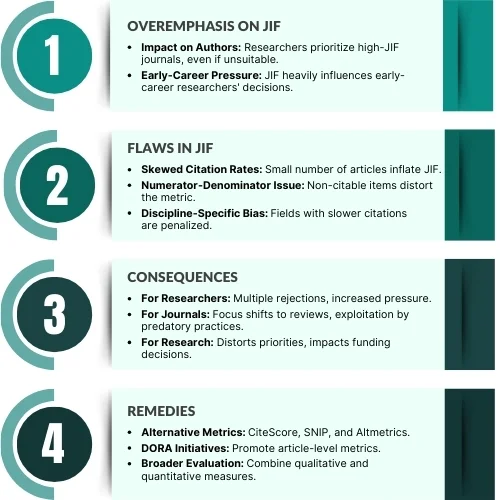- Home
- Insights
- The Tyranny of the Journal Impact Factor: Understanding Its Influence and Remedies
The Tyranny of the Journal Impact Factor: Understanding Its Influence and Remedies
The Tyranny of the Journal Impact Factor: Understanding Its Influence and Remedies


Dr.Nancy | Research design and Mixed Methods Research.
29 Jan, 2025

Dr.Nancy | Research design and Mixed Methods Research. 29 Jan, 2025
Introduction: What is the Journal Impact Factor (JIF)?
The Misuse and Limitations of the JIF
- The Overemphasis on JIF
- Impact on Author Decisions: Researchers often prioritize submitting to high-JIF journals, even if the journal is unsuitable for their work. A 2020 study showed a direct correlation between JIF changes and submission numbers.
- Impact on Early-Career Researchers: Studies reveal that JIF is a top consideration for early-career researchers across disciplines and geographies.
- Flaws in the Metric
- Discipline-Specific Citation Rates: JIF penalizes journals in fields where citations accumulate more slowly [3].
- Skewed Distribution: A small number of highly cited articles disproportionately inflates the JIF.
- Numerator-Denominator Asymmetry: Non-citable items like editorials contribute to the numerator but not the denominator.
- Unethical Practices to Boost JIF
- Self-Citation: Journals may request authors to cite articles from the same journal to inflate its JIF artificially.
- Citation Cartels: Groups of authors or journals collaborate to boost citations.
- Review Content Bias: Journals publish excessive review articles, which are cited more frequently than original research, leading to an over-reliance on reviews [1].
- Misrepresentation of Article Quality
The biggest issue with JIF is its application to individual articles. JIF was never designed to predict an article’s citations or scientific value, as citation distribution within journals is highly skewed [4].

Figure 1: The Tyranny of the Journal Impact Factor: Understanding Its Influence and Remedies
Consequences of Overemphasizing JIF
- For Researchers
- Repeated Rejections: Authors submitting to high-JIF journals face multiple rounds of rejection, delaying publication and increasing costs [1]. [5]
- Pressure on Early-Career Researchers: Young scientists feel compelled to publish in high-JIF journals, potentially compromising the quality of their research.
- For Journals
- Focus on Reviews: Excessive publication of reviews and special issues skews academic focus and journal priorities [1]. [5]
- Exploitation by Predatory Practices: Paper mills and predatory journals exploit JIF by artificially inflating citations.
- For the Research Community
- Distortion of Research Priorities: Over-reliance on JIF shifts focus from research quality to perceived journal prestige.
- Impact on Funding and Careers: Institutions and funding bodies misuse JIF as a proxy for individual researcher performance, leading to inequitable outcomes.
Table 1: Comparing JIF with Alternative Metrics
| Metric | Data Source | Key Features | Limitations |
|---|---|---|---|
| JIF | Web of Science | 2-year citation window, average citations | Discipline bias, skewed distribution |
| CiteScore | Scopus | Longer citation window, consistent numerator/denominator | Still averages citations, discipline bias |
| SNIP | Scopus | Accounts for citation potential across disciplines | Limited adoption |
| Altmetrics | Online mentions | Tracks views, downloads, and social media mentions | Weak correlation with citations |
Remedies for JIF's Influence
- Adoption of Alternative Metrics
Several new metrics have emerged to address JIF’s shortcomings:
- CiteScore: Uses Scopus data, longer citation windows, and consistent numerator/denominator.
- SNIP (Source Normalised Impact per Paper): Considers field-specific citation potential, allowing for cross-disciplinary comparisons.
- Altmetrics: Tracks article-level metrics like views, downloads, and social media mentions [1].
- Initiatives like DORA
The San Francisco Declaration on Research Assessment (DORA), announced in 2012, advocates for reducing reliance on journal-based metrics:
- Publisher Recommendations: Use article-level metrics and avoid promoting JIF alone.
- Article-Level Metrics: Include citations, downloads, and social media activity to assess article quality [6].
- Broadening Evaluation Criteria
- Qualitative Indicators: Assess the significance of a researcher’s contributions beyond numerical metrics.
Multifaceted Approach: Use a combination of metrics to evaluate journals, articles, and researchers [7].
Contact us today to learn how we can help you navigate the complexities of ethical publishing and prevent plagiarism in your research
We offer the expertise, knowledge, and comprehensive support your Clinical research and publication needs.
Future Directions: Research on Fake Papers
The Way Forward
- Focus on Article-Level Metrics: Shifting from journal-level metrics like JIF to article-specific indicators can provide a fairer evaluation of research impact.
- Institutional Change: Funding and promotion criteria should focus on research quality and societal impact rather than journal prestige.
Education and Advocacy: Researchers and institutions must be educated about the limitations of JIF and the value of alternative metrics [8].
